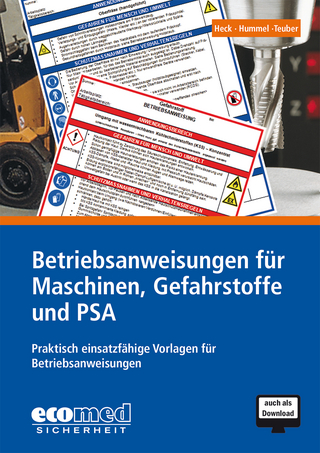
Process Control – A Practical Approach
Wiley-Blackwell (Hersteller)
978-0-470-97656-2 (ISBN)
- Keine Verlagsinformationen verfügbar
- Artikel merken
So why another book on process control? Process Control: A Practical Approach is a ground-breaking guide that provides everything needed to design and maintain process control applications. The book follows the hierarchy from basic control, through advanced regulatory control, up to and including multivariable control. It addresses many process-specific applications including those on fired heaters, compressors and distillation columns. Written with the practicing control engineer in mind, the book: Brings together proven design methods, many of which have never been published before Focuses on techniques that have an immediate practical application Minimizes the use of daunting mathematics - but for the more demanding reader, complex mathematical derivations are included at the end of each chapter Covers the use of all the algorithms, common to most distributed control systems This book raises the standard of what might be expected of even basic controls. In addition to the design methods it describes any shortcuts that can be taken and how to avoid common pitfalls. Proper application will result in significant improvements to process performance.
Myke King's practical approach addresses the needs of the process industry, and will improve the working practices of many control engineers. "This book would be of value to process control engineers in any country." - Mr Andrew Ogden-Swift, Chairmain, Process Management and Control Subject Group, Institution of Chemical Engineers, UK "This book should take the process-control world by storm." - Edward Dilley, Lecturer in Process Control, ESD Simulation Training
About the Author Myke King is the Director of Whitehouse Consulting, UK, an independent consulting organisation specialising in process control.
Preface. About the Author. 1. Introduction . 2. Process Dynamics. 2.1 Definition. 2.2 Cascade Control. 2.3 Model Identification. 2.4 Integrating Processes. 2.5 Other Types of Process. 2.6 Robustness. 2.7 Laplace Transforms for Processes. References. 3. PID Algorithm. 3.1 Definitions. 3.2 Proportional Action. 3.3 Integral Action. 3.4 Derivative Action. 3.5 Versions of Control Algorithm. 3.6 Interactive PID Controller. 3.7 Proportional-on-PV Controller. 3.8 Nonstandard Algorithms. 3.9 Tuning. 3.10 Ziegler-Nichols Tuning Method. 3.11 Cohen-Coon Tuning Method. 3.12 Tuning Based on Penalty Functions. 3.13 Manipulated Variable Overshoot. 3.14 Lambda Tuning Method. 3.15 IMC Tuning Method. 3.16 Choice of Tuning Method. 3.17 Suggested Tuning Method for Self-Regulating Processes. 3.18 Tuning for Load Changes. 3.19 Tuning for Unconstrained MV Overshoot. 3.20 PI Tuning Compared to PID Tuning. 3.21 Tuning for Large Scan Interval. 3.22 Suggested Tuning Method for Integrating Processes. 3.23 Implementation of Tuning. 3.24 Loop Gain. 3.25 Adaptive Tuning. 3.26 Initialisation. 3.27 Anti-Reset Windup. 3.28 On-Off Control. 3.29 Laplace Transforms for Controllers. 3.30 Direct Synthesis. References. 4. Level Control. 4.1 Use of Cascade Control. 4.2 Parameters Required for Tuning Calculations. 4.3 Tight Level Control. 4.4 Averaging Level Control. 4.5 Error-Squared Controller. 4.6 Gap Controller. 4.7 Impact of Noise on Averaging Control. 4.8 General Approach to Tuning. 4.9 Three-Element Level Control. 5. Signal Conditioning. 5.1 Instrument Linearisation. 5.2 Process Linearisation. 5.3 Constraint Conditioning. 5.4 Pressure Compensation of Distillation Tray Temperature. 5.5 Pressure Compensation of Gas Flow Measurement. 5.6 Filtering. 5.7 Exponential Filter. 5.8 Higher Order Filters. 5.9 Nonlinear Exponential Filter. 5.10 Averaging Filter. 5.11 Least Squares Filter. 5.12 Control Valve Characterisation. 5.13 Equal Percentage Valve. 5.14 Split-Range Valves. 6. Feedforward Control. 6.1 Ratio Algorithm. 6.2 Bias Algorithm. 6.3 Deadtime and Lead-Lag Algorithms. 6.4 Tuning. 6.5 Laplace Derivation of Dynamic Compensation. 7. Deadtime Compensation. 7.1 Smith Predictor. 7.2 Internal Model Control. 7.3 Dahlin Algorithm. References. 8. Multivariable Control. 8.1 Constraint Control. 8.2 SISO Constraint Control. 8.3 Signal Selectors. 8.4 Relative Gain Analysis. 8.5 Steady State Decoupling. 8.6 Dynamic Decoupling. 8.7 MVC Principles. 8.8 Parallel Coordinates. 8.9 Enhanced Operator Displays. 8.10 MVC Performance Monitoring. References. 9. Inferentials and Analysers. 9.1 Inferential Properties. 9.2 Assessing Accuracy. 9.3 Laboratory Update of Inferential. 9.4 Analyser Update of Inferential. 9.5 Monitoring On-stream Analysers. Reference. 10. Combustion Control. 10.1 Fuel Gas Flow Correction. 10.2 Measuring NHV. 10.3 Dual Firing. 10.4 Inlet Temperature Feedforward. 10.5 Fuel Pressure Control. 10.6 Combustion Air Control. 10.7 Boiler Control. 10.8 Fired Heater Pass Balancing. 11. Compressor Control. 11.1 Polytropic Head. 11.2 Flow Control (Turbo-Machines). 11.3 Flow Control (Reciprocating Machines). 11.4 Anti-Surge Control . 12. Distillation Control. 12.1 Key Components. 12.2 Relative Volatility. 12.3 McCabe-Thiele Diagram. 12.4 Cut and Separation. 12.5 Effect of Process Design. 12.6 Basic Controls. 12.7 Pressure Control. 12.8 Level Control. 12.9 Tray Temperature Control. 12.10 Pressure Compensated Temperature. 12.11 Inferentials. 12.12 First-Principle Inferentials. 12.13 Feedforward on Feed Rate. 12.14 Feed Composition Feedforward. 12.15 Feed Enthalpy Feedforward. 12.16 Decoupling. 12.17 Multivariable Control. 12.18 On-stream Analysers. 12.19 Towers with Sidestreams. 12.20 Column Optimisation. 12.21 Optimisation of Column Pressure. 12.22 Energy/Yield Optimisation. References. 13. APC Project Execution. 13.1 Benefits Study. 13.2 Benefit Estimation for Improved Regulatory Control. 13.3 Benefits of Closed-Loop Real-Time Optimisation. 13.4 Basic Controls. 13.5 Inferentials. 13.6 Organisation. 13.7 Vendor Selection. 13.8 Safety in APC Design. 13.9 Alarms. References. Index.
| Erscheint lt. Verlag | 13.12.2010 |
|---|---|
| Verlagsort | Hoboken |
| Sprache | englisch |
| Maße | 168 x 244 mm |
| Gewicht | 666 g |
| Themenwelt | Naturwissenschaften ► Chemie ► Technische Chemie |
| Technik ► Elektrotechnik / Energietechnik | |
| Technik ► Maschinenbau | |
| ISBN-10 | 0-470-97656-X / 047097656X |
| ISBN-13 | 978-0-470-97656-2 / 9780470976562 |
| Zustand | Neuware |
| Haben Sie eine Frage zum Produkt? |
aus dem Bereich
